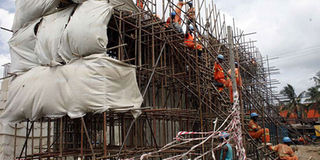New index will spur infrastructure investment

This image taken on January 13, 2019 shows ongoing construction of Jomvu-Magongo interchange in Mombasa. Physical infrastructure continues to be a challenge in Africa. PHOTO | FILE | NATION MEDIA GROUP
What you need to know:
- Physical infrastructure continues to be a challenge in Africa and is often a major barrier to boosting intra-continent trade.
- For years, those who have invested in African infrastructure projects have enjoyed high risk-adjusted returns over the long term.
Persistent underfunding of critical infrastructure worldwide is hampering economic progress and exposing businesses and communities to significant risks.
This year’s risk perception survey, which underpins the Global Risks Report 2019, highlights the need for a renewed global focus on infrastructure resilience and investment.
Although there is consensus among governments and businesses on the importance of infrastructure to a growing economy and evolving society, the world continues to underinvest.
Worldwide investment in infrastructure is expected to be $79 trillion by 2040. However, the actual global investment need is closer to $97 trillion.
To close this $18 trillion gap, average annual global infrastructure investment would need to increase by approximately 23 per cent per year.
However, in underdeveloped regions, new infrastructure is predominantly required to enable economic development and meet basic needs such as utilities and transport networks.
BENCHMARK
Physical infrastructure continues to be a challenge in Africa and is often a major barrier to boosting intra-continent trade.
Although there has been continued investment in telecommunications and technology infrastructure, there has also been a significant increase in demand and usage.
For institutional investors, one of the main constraints holding back infrastructure investment in Africa is the lack of a benchmark.
Infrastructure performance indices over the rest of the world are common, as they play a critical role in evaluating the risk/return profile of investing in this asset class.
The lack of such benchmarks contributes to a dearth of much-needed investment in this asset class.
RETURNS
To fill this gap and boost investment, RisCura has partnered with Africa investor (Ai) Capital (a pan-African institutional infrastructure co-investment platform), to launch Africa’s first infrastructure performance index in 2019.
This index will facilitate increased investment into the continent’s infrastructure, benefiting not only the people of Africa, but investors, too.
For years, those who have invested in African infrastructure projects have enjoyed high risk-adjusted returns over the long term.
The default rate is low and the returns are attractive, more than risk. In other words, investing in African infrastructure presents an exciting opportunity.
But without historical data and benchmarks, it’s not easy for newcomers to evaluate the investment case.
The Infrastructure Performance Index will be released quarterly, starting this year.
ASSETS
The index will be pan-African in coverage and include a wide range of unlisted investment assets, covering all conventional sectors: power, transport, renewable energy, and information and communications technology.
It will comprise assets at both the fund level, as is traditionally done in most infrastructure indices, and the asset level.
This gives access to more information, enables splitting the life of the assets between greenfield and brownfield, and reflects the different types of performance more accurately. Assets will need to be valued quarterly.
The writer is a business leader and director East African Business Council





